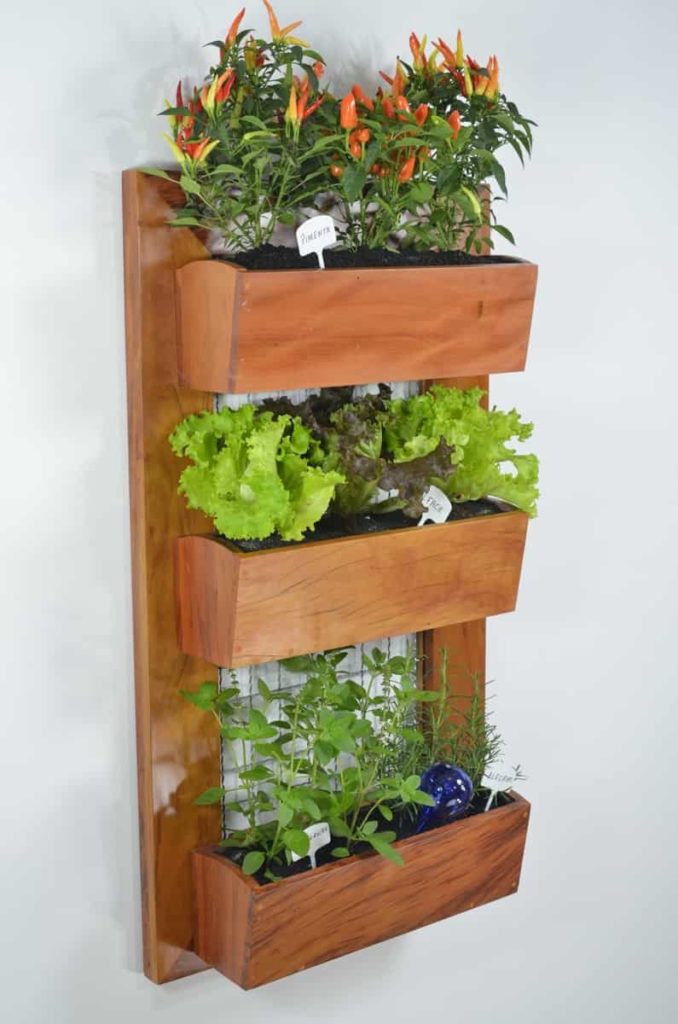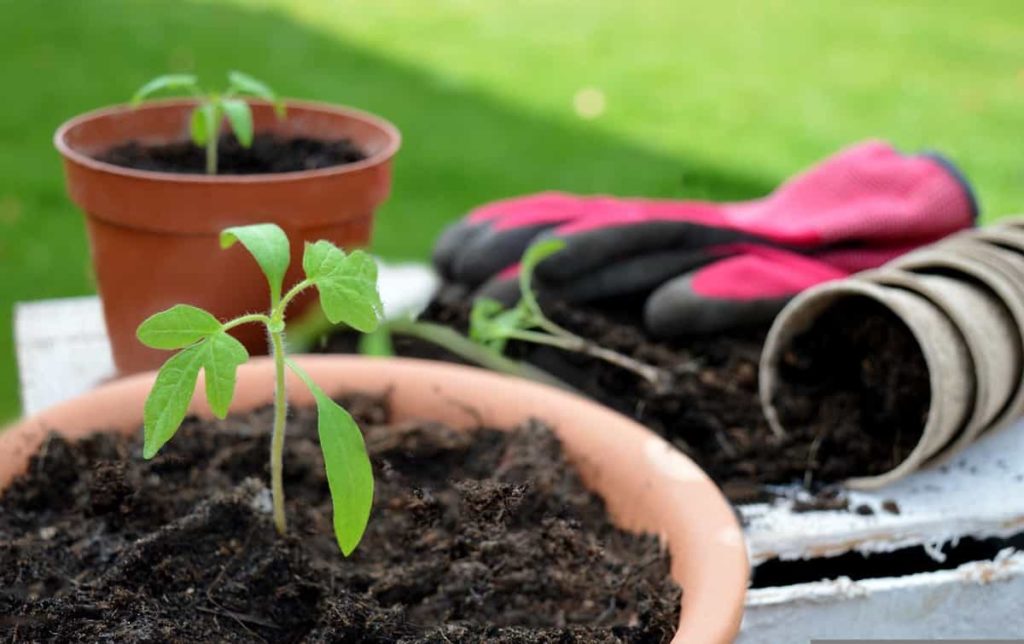Vegetable gardening is an activity that can give fresh, flavorful produce. It offers many benefits as other gardening activities, including exercise, fresh air, landscape beautification, and enjoyment. It promotes a nutritious diet at a lower cost by reducing food expenditures more than the costs associated with growing vegetables. Homegrown veggies taste better than what they can buy at a supermarket, thanks to the freshness and more choice of varieties. Vegetables are generally annual plants, whereas fruit crops are produced from perennial plants.

Top 31 vegetable garden ideas at home
Make use of hanging baskets
Use walls, fences, or even ceilings to modern garden ideas by adding a hanging basket to a compact outdoor garden set-up. Hanging baskets can save space and add style and a more authentic look to any empty spot. Strawberries in hanging baskets are easy and fun to grow, and having them in hanging baskets will often keep them out from common garden pests. Try growing a large variety of plants which can give more attractiveness and its tasty fruits.
Filling the balcony with planters and pots
Put various balcony ideas to good use and make it work even harder by hanging planters over the small terrace or fence. Coming with an integrated water reservoir, so the veggies in the garden do not get thirsty. Different dwarf varieties of vegetables can be grown in small areas. Lettuce and Runner Bean do not take up much space, and a wide range of varieties of tomato have been created for growing in pots like the Balconi Yellow tomato type.
Try vertical gardening
Vertical gardening is a kind of special urban gardening, and it is well suited for small spaces, particularly for decorating walls and roofs in different styles. This vertical gardening is an alternative method for gardening by increasing the scope of growing plants in a vertical space. Everyone will not have sprawling gardens with acres and acres of land. Instead of thinking of traditional gardening, grow upwards and create a living wall to help maximize the outdoor area.
In case you missed it: Top 47 Home Garden Ideas for Small Spaces: Check How this Helps Beginners
Vertical herbs garden
Vertical gardens look best with equally spaced small pots of the same size with green herbs. These herbs can add extra flavor to the cooking with fresh herbs from the garden. Generally, go for reliable choices, such as running herbs that regenerate after being cut back hard, salad leaves, sugar snap peas, and strawberries.
Create a vertical herb garden close to the kitchen, preferably on a wall that gets some amount of sunlight during the day. Most herbs require sunlight; however, some will grow in low light. In some cases, supplement the outdoor lighting by adding track lights with sun lamps over the pots, if required.
Use of vertical space in small spaces
Some vegetables, like peas and beans, need structural support to grow, and use these support structures to support larger vegetables, like growing pumpkins. Pumpkins need more area to grow horizontally, which is a major issue if the gardening space is very short. However, growing them with support can give bumper crops while also growing other vegetables in the surrounding beds.
Add a seating area in the vegetable garden
A dedicated seating area incorporated, whether a bench or arbor in the vegetable garden, gives a space to relax and enjoy the beauty and productivity of the garden. It provides a handy spot for that all-important coffee break.
Use edging to define the vegetable garden limits
Adding a border to the vegetable garden helps define the garden’s limits. Borders can also help to zone the vegetable garden and demarcate its pathways. Various lawn and garden edging ideas can be repurposed to organize the vegetable garden. Choose natural materials like woven willow, flagstones, or bricks to complement the garden planting, letting the borders mix into the plot rather than stand out.
Draw on vegetable garden ideas to create a productive kitchen garden
Neat rows of fluffy carrot tops, onion leaves, and ruffled lettuce create the quintessential garden look. One of the simple vegetable garden ideas is creating borders by turning over the lawn or repurposing the existing bed. Then prepare the bed until the soil is fine and crumbly before planting the seeds or seedlings.
In case you missed it: California Vegetable Planting Calendar (CA): Month Wise Chart, Zone 5, Zone 6, Zone 7, Zone 8, Zone 9, Zone 10, and Seasons

Plant the vegetable crops successionally and leave a month or so between sowings. This gap between sowing gives delicious fresh vegetables ready to pick throughout summer. Choose a plot as large enough to grow all your favorite vegetables for home.
Implement vegetable garden ideas into a terrace planting scheme
Establishing a vegetable garden in the patio or terrace design adds a productive angle to the patio space. Either create beds amongst the gravel, tiles, or flagstones or go for a few artfully placed pots growing with your favorite vegetables. There are different decorative choices to tuck in, including frilly lettuces and cabbages, architectural cardoons, runner beans, and peas. And also, shimmering stems of rainbow chard and clouds of feathery asparagus and fennel can give an authentic look to the garden.
Incorporate pathways
Adding borders and paths will instantly elevate the garden plot, giving it structure and order. Unlike a flower border, incorporating access paths is an important part of vegetable garden ideas. Paths are needed to reach the plants for tending and harvesting. Not only aiding access, but garden path ideas also create an organized vegetable garden.
The various materials chosen for the paths can create different effects in the vegetable garden. Pebbles are a great choice for laid-back cottage garden ideas. These paths excellently pair with arches covered in floral blooms and large terracotta planters to embrace the romantic potager aesthetic. Brick paths create a more formal and organized look while evoking a natural garden feel. The red shade of the bricks also highlights the deep green leaves of the vegetable.
Embrace grafted fruit trees to maximize space
When the space is limited and does not have to have an orchard to grow, dwarf fruit trees are some of the popular trees for small gardens. These plants can be planted directly into an ornamental bed, valued for their pretty blossom and fruits. These pants can be planted along with roses as ideal companions.
Various dwarf varieties will thrive as part of your small vegetable garden ideas, from apples and pears to cherries and apricots. If the space is short, go for grafted fruit trees. In these fruit trees, two different trees are grafted onto a single rootstock—this grafting gives multiple varieties of fruit from one tree. For example, an apple combines with pears on a single trunk.
Try to grow vegetables over the pergola
Vertical gardening is a great way to design a small vegetable garden. Traditionally rambling roses are the best flowering climbers for training over a pergola. And also use them to support vegetable vines. The best vegetables to pair with pergola ideas are cucumbers, squash, pumpkins, and beans, which require a support system to grow.
Implementing vertical gardening will make the most of the available space and help protect them from slugs and other pests. When growing veggies over a pergola, it is easy to reach the fruit as it grows. This idea can also save on the garden’s water consumption as the plant’s roots are confined to a much smaller surface area.
In case you missed it: Top 47 Home Garden Ideas for Small Spaces: Check How this Helps Beginners

Grow veggies in window sills
If there are deep window sills at home, add a window box to the outdoor space. They add interest to your home and are a great way to maximize the planting space if the back garden is on the small side. For a stylish look, go for matching window boxes and could try adding color to coordinate with the plants that want to grow. By growing the veggies on the kitchen window sill or in a window box, it is easy to reach out of the window and grab a handful while cooking up a culinary storm in the kitchen.
Build a raised bed vegetable garden
Raised garden bed ideas are more popular for growing edibles as part of the small vegetable garden. Wood or brick can frame the bed, fill those beds with good-quality soil, and add fruit or vegetable crops. Rotating the crops ensures pests and diseases do not build up. Salad leaves are fast, easy, and fun to grow in a pot or a small bed. The best bit is that cut them once; they will regrow for a second harvest.
Look for vertical vegetable garden ideas to save space
Old ladders, stacked containers, palettes, metal stands, and outdoor plant stands can be used for a vertical vegetable garden and various options for small vegetable gardening, even in a small garden with decking. Use fences or walls with wire, twine, or lattice for beans and peas. Train vines up on pergolas and create edible screens or step-over edging. Attach pots to walls and use one of the many commercial living wall systems available.
Use on pots or containers when space is tight
In small space gardening, you only need a willingness to grow, some water, sunlight, and pots to sow seeds. Container or pot gardening can be the way to go when space is tight. A window, patio, or balcony is needed to place the pots to grow crops as long as you have good soil, plenty of sunlight, and water.
Container gardens are great for small spaces that can grow almost all fruit, vegetables, or herbs. It is easier to grow plants in large containers than in small ones. Large containers can accommodate more soil, which stays moist for a long time and resists rapid temperature fluctuations.
Plant a small vegetable garden amongst flowers
Small vegetable garden ideas require creative thinking. The vegetable or fruit plants can be blended attractively along with other plants. For small vegetable garden ideas, Decorative choices include frilly lettuces and cabbages, architectural cardoons, runner beans and peas scrambling up tepees, rainbow chard, feathery asparagus, and fennel.
Scattered edibles allow for staggered cropping and avoid the situation of feast or famine and patches of empty soil. Smaller edibles, such as chives, parsley, and carrots, will make attractive edging to garden beds. Never-ending herbs look good year-round, such as sage and ground-covering with pretty flowers. Adding veg and fruit among the flowerbeds has the practical advantage of creating a tapestry of colors and scents that confuses insect pests. Flowering herbs will also attract beneficial insects.
Incorporate a small vegetable garden in a window box
Window and planter box ideas are well suited to grow low-growing kitchen garden edibles like herbs and salad leaves and need to set the conditions at the window sill. Planting includes a different mix of mints and strawberries interspersed with parsley with micro greens, salad leaves, chives, basil, and edible flowers.
In case you missed it: Top 47 Home Garden Ideas for Small Spaces: Check How this Helps Beginners

Grow fruit trees in containers
Including a lot of fruit in the small vegetable garden ideas is possible. Most fruit trees prefer a sunny position, making them perfect when planning roof garden ideas, but if your garden is planned in semi-shade, many choices will still do well. These trees can also be lovely growing in pots in a range of patio ideas, so they are close to hand when you are tempted to pluck a ripe fruit off the bush as you sit and enjoy your garden.
Decorate with your vegetable plants
Some vegetables, like Swiss rainbow chard, are beautiful to grow in the vegetable garden. Show these plants off by making them focal points in the garden. Once they fill out, this Swiss rainbow chard will be more attractive. And when you harvest the outer leaves, new leaves will fill in, keeping the plants fresh and authentic-looking.
Vegetables can be grown in containers. This container growing can be a creative and ornamental way to design a vegetable garden. Containers can be shifted about to take full advantage of the sunlight. Sow the seeds, plant one type of veggie per container, or mix things up. The bottom soil in containers tends to dry out quickly, so water them daily.
Vegetable bedding plants
Many vegetables are attractive bedding plants, especially quick growers, and frequently harvested, like lettuce and other salad greens. A shady place under a tree is the best place to grow them. For example, plant a row of carrots on edge around a sunny border. Rabbits and other wildlife may find these vegetable beds tempting, but interplant these veggies with companion flowers with a strong scent or toss in a few onion plants; these will act as a deterrent.
Change the garden pallet
Old, discarded pallets make great compost bins. They will make great vertical gardens too. Staple some fabric to the inside of the front of the pallet and the rear outside. Fill them with good potting soil, turn the pallet on its side and make slits to insert the plants. Use sturdy and strong hooks to hang the baskets because all that soil and wood make them very heavy.
Grow crops that offer rich rewards
One secret trick for a successful small vegetable garden is to grow small amounts of different crops that offer big rewards. Go for easy bumper crops like cut-and-come-again salad leaves, chilli plants, fresh herbs, leafy greens, and super-sweet peas. Certain varieties of plants have been considered front runners in the time-to-reward ratio. These plants are the ones that are quick and easy to grow so that they will do well. It is best suggested that plants the veggies that are cut-and-come-again leaves every time.
Use trellis for compact vegetable garden
The idea of a super-smart small vegetable garden is to try a vegetable garden on the trellis. This idea will save most space by using vertical surfaces to grow crops, which is particularly useful for incorporating vegetable plants into the courtyard garden. Add in some herbs planted pots, which make excellent and can also be beneficial for companion planting.
Gardening inside the box
A simple crate is required to plant a salad garden that will feed for weeks. This box gardening is a variation on a raised bed garden, but since it is self-contained and portable. Try to plant vegetables harvested frequently, such as lettuce, carrots, and onions, which will be thinned out as harvest them frequently, so there will not be overcrowding.
The containers may be too heavy to lift when it is full, so put wheels below them and can move them to wherever the sun decides to shine. Sprinkle a balanced, organic fertilizer in the soil before or after planting. Do not over-fertilize, as plants will grow too quickly if they are over-fertilized. So they will be more likely to flop over, and the flavor will not be as rich.
Taking raised beds to new heights
Raised beds are only a few inches above the ground. These raised beds will benefit the plants with improved drainage and warming of the soil earlier in spring. Lifting the planting beds to waist height, like the three weathered troughs running through this colorful garden, means minimal bending and fewer wildlife problems that would otherwise need additional fencing.
Go for a small greenhouse
Greenhouse ideas are one of the essential parts of the vegetable garden. Plants can be grown in greenhouses without the challenge of predicting the frost or worrying about where they will live. A greenhouse can delay the effects of frost by several weeks and maximize the yield of crops, such as picking fresh tomatoes.
In case you missed it: Ohio Vegetable Planting Calendar: Month-by-Month Chart, Season, and Easiest Vegetables to Grow

In the summer months, a mini greenhouse can be used to grow traditional greenhouse plants, such as tomatoes, peppers, cucumbers, and herbs. During winter, a mini-greenhouse can also be used to plant more temperature-sensitive crops.
Make use of vertical height with hanging baskets
Hanging baskets can also be used to grow a wide range of vegetables, helping to increase the productivity of the small vegetable garden. Taking up no ground space, they provide a versatile growing platform for a wide range of vegetables like lettuce, rocket, and spinach. These hanging baskets can be used for growing tomatoes or as herb planter ideas. Since the vegetables are elevated above the ground, they are inaccessible to slugs, snails, rabbits, and other animals who may decimate when grown at ground level – protecting them from this helps to boost your yields.
Convert the roof or balcony into a Garden
Most buildings’ roofs are often used in a space that is not used to its fullest potential. The rooftop can be a charming space used for gardening. Sunlight can be fully exposed on the roof, so gave large planter boxes filled with seasonal vegetables and herbs. Even with a tiny balcony, there are various ideas to carve out some space for greenery. Plan for rectangular planter boxes deep enough to allow proper root growth. 6 to 7 inches of soil is usually a minimum for proper rooting. The planter boxes must have proper waterproofing at the bottom.
Utilize space below the staircase
The space below the stairs is wasted in many homes. This space can be utilized better and could be the perfect space for a small garden. Pebbles, rocks, and flowing water can add visual and textural interest to this space. However, these plants will need some sunlight during the day as, typically, this area would not have access to much light.
Some vegetables grow well indoors, like radishes, turnips, lettuce, greens, and carrots. Citrus fruits, tomatoes, and eggplants are also very popular. Basil, parsley, coriander, and mint are possible choices for herbs that are easy to grow. There are a great many benefits to growing indoor plants. Not only do they look beautiful, but they also clean the air, absorb indoor heat and add humidity.
Incorporate a water but harvest the rainwater to water the plants
Water butts are not just economic but also far better for the plants than water from the tap. Rainwater is pure and untreated. Rainwater to tap water for the garden plants because it does not contain the chemicals needed to meet tap water drinking quality. Adding a water butt is a brilliant step to harvest rainwater that can use later to water the crops.
These are other sustainable garden ideas to help make your veg plot more environmentally friendly. Sustainability is most important in every walk of our lives, and the garden is no different. Incorporating vegetable garden ideas into the backyard is a great way to reduce the carbon footprint.
- Aquaponic Farming at Home: A Step-By-Step Guide
- Profitable Village Farming Business Ideas in 2024
- High-Yield Aquaculture: Fast-Growing Fish for Farming
- Effective Fish Pond Construction Techniques for Beginners
- Irrigation and Water Management in Pineapple Farming
- Blossom to Harvest: Mastering Flowering and Pollination in Papaya Farming
- Pig Fattening Essentials: From Selection to Sale for Beginners
- Raising Wagyu Cattle: A Complete Guide for Premium Beef Production
- Soil Types and Their Water Holding Capacity
- Optimizing Irrigation Schedules for Coconut Groves for Enhanced Yield
- Espresso Your Garden: Coffee Grounds for Healthier Acid-Loving Plants
- The Best Soil Mix for Snake Plants: How to Mix Your Own Snake Plant Soil
- Green Thumb Success: Expert Tips for Cultivating Greenhouse Beans All Year Round
- Bloom All Year Round: The Ultimate Guide to Indoor Hyacinth Care
- Eco-Friendly Gardening: How to Make Liquid Fertilizer from Kitchen Waste
- Ultimate Guide to Grow Anise in Pots: Explore Seed Propagation to Harvesting
- Guide to Raising Chester White Pigs: Discover Breed Facts to Growth Management
- Mastering the Elegance: The Ultimate Guide to Weeping Cherry Tree Care, Planting, and Maintenance
- Ultimate Guide to Planting Garlic in Grow Bags: Growing Strategies for Beginners
- How to Fix Spider Plant Leaf-Related Problems: Natural and Organic Remedies
- 10 Reasons Why Your Tulsi Plant is Shedding Leaves: Home Remedies and Solutions
- Optimizing Growth and Yield: The Advantages of Palm Bunch Ash Fertilizer
- Utilizing Neem Oil Extract as a Natural Pesticide for Hydrangea
- From Soil to Harvest: Various Ways in Which Farmers Can Use AI Tools
- Steps to Encourage and Induce Citrus Flowers: A Comprehensive Guide
- How to Fix Snake Plant Leaf-Related Issues: Natural and Organic Remedies
- Transform Your Garden into a Fragrant Oasis with Raat Ki Rani (Night Blooming Jasmine)
- Discover the Ideal Chicken Breeds for Philippine Farms
- How to Create a Poultry Egg Farm Business Plan for Profits
- Grow Lemon Cucumbers Like a Pro: Insider Techniques for Bountiful Yields
- Ultimate Guide to Caring for Your Pink Princess Philodendron: Tips for Thriving Variegation
- Areca Nut Profit Per Acre: Calculating Yield and Cost of Cultivation
- How Kaveri Chicken is Becoming a More Profitable Breed in Indian Backyards
- Transform Your Barn: 9 Steps to Convert a Horse Stall into a Chicken Coop
- Exploring Suffolk Sheep Disadvantages with Limitations and Challenges
- Guide to Solving Potted Lemon Tree Problems: How to Revive Lemon Tree in Containers

